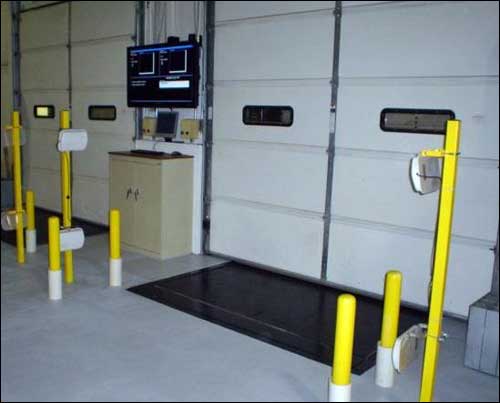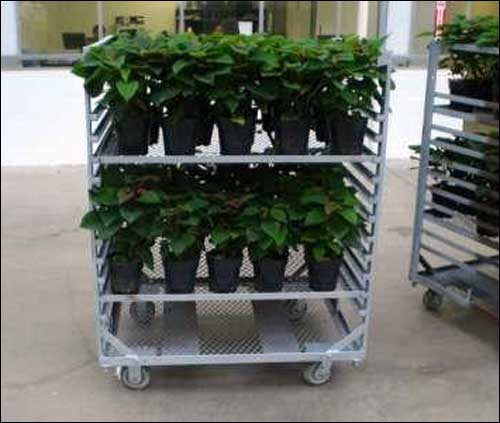After four years of trial and error with RFID systems, Color Point, a plant grower in Paris, Ky., has completed its busiest season (spring) with an RFID system that provides the company with visibility into where its metal carts are located, as well as when and to which retailer they were shipped, and when they were returned. In addition, the warehouse staff can load the trucks more efficiently by following a display screen integrated into the RFID system that instructs which carts to load, and in what order, according to which stop they are destined for.
Color Point provides ornamental bedding plants to stores in Kentucky, Indiana, Ohio, Tennessee and West Virginia. The greenhouse from which all of its plants originate spans approximately 15 acres, and ships an average of 25 truckloads of plants out of two dock doors daily. That, says Brad Slattery, Color Point’s IT manager, makes it one of the fastest loading operations in the nursery business.
The company’s 6,000 metal carts on which the plants are loaded—basically, display shelves on wheels—are shipped directly to Lowe’s or other stores, then are wheeled to the storefront, where the plants are displayed for sale. Once the carts are empty, Color Point’s trucks pick them up and return them to the Paris nursery location for reuse. Manually tracking the carts on paper as they were shipped into and out of the nursery was an ineffective solution for Color Point.
In some cases, for instance, carts ended up remaining at the store, loaded with other merchandise, or were simply lost, and it was difficult for the staff to know where and when each of the $400 to $500 carts was sent, as well as whether it was returned. What’s more, Color Point’s drivers would periodically pick up empty carts at retail locations, but it was difficult to know how many carts were ready for pick-up, thus making it harder to schedule a pick-up at the optimum time (when the truck could be loaded with empties, but before there was a backup of excess carts).
To resolve the problem, Slattery says, Color Point had tried to track the carts by means of bar-coding, but found that scanning bar-coded labels was time-consuming and fraught with problems. So approximately four years ago, the firm began experimenting with systems from several RFID providers using high-frequency (HF) 13.56 passive RFID tags. The company installed interrogators at each of the two loading docks, with antennas embedded in the floor, and tagged the bottoms of carts. However, he notes, the tags did not read reliably, so Color Point pulled the antennas out of the concrete and moved them to a different location at the loading dock. Despite these efforts, it still could not obtain a suitable read range. “If the infrastructure isn’t there to give you 100 percent read rates,” Slattery states, “then nothing will work.”
In early 2008, Slattery says he began discussions with SATO, which offered to provide a system with a 100 percent read rate. SATO replaced the HF readers with ultrahigh-frequency (UHF) interrogators from Alien Technology, and installed two readers, one for each of the two dock doors, with antennas mounted above the floor. The firm placed Avery Dennison‘s AD-222 EPC Gen 2 tags on the bottoms of the carts, according to John Anderson, SATO’s national sales manager, and provided its iTrack software, which resides on Color Point’s back-end system, to enable the nursery to create loading plans for each trailer, as well as track the shipment of each cart.
The resulting system enables Color Point to load trucks faster and more efficiently by knowing how many carts are intended for which location—and, thus, where they should be loaded in the trucks. When a trailer is loaded, data regarding that shipment and trailer number are entered into the system, which can be accessed at a PC within the warehouse. A screen cabled to that PC then displays a diagram of the truck, with squares to signify each cart. The system displays a list of which carts need to be loaded, as well as in what order, based on their ID numbers and descriptions. A truck will typically have several stops on its route, with the system designed so that the trailer is loaded in such a way that the carts can be unloaded in the order of the stops, without requiring repacking.
Color Point employed a SATO GL408e thermal printer and RFID encoder to write a unique ID number to the RFID labels, then fitted each cart with two labels—one above the front right wheel, the other above the front left—encoded with the same ID number. When a cart passes through either of the two dock doors, the RFID interrogator at that location captures its tag ID number and transmits that information to the iTrack system via a cabled connection. The tag’s unique identifier is linked to the shipment number in the system, thereby allowing Color Point’s management to know when the cart was shipped, to which store and in which truck. Warehouse workers can then look on the screen to see what they have loaded, which cart should be loaded next and whether they have loaded any incorrect carts.
When an empty cart is returned to Color Point’s facilities, the interrogators capture its tag ID number, thereby documenting the return against the retail customer’s account.
The system makes it possible for the company’s management to track the length of time carts are in specific retail locations, thereby knowing how many empty carts will be available and approximately when, thus allowing for fewer trips to pick up empties.



